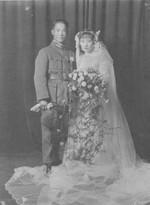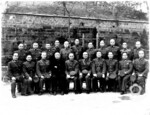Chen Cheng
| Surname | Chen |
| Given Name | Cheng |
| Born | 4 Jan 1897 |
| Died | 5 Mar 1965 |
| Country | China |
| Category | Military-Ground |
| Gender | Male |
Contributor: C. Peter Chen
ww2dbaseChen Cheng, courtesy name Chen Cixiu, was born in Qingtian, Zhejiang, China. He graduated with the 8th class of the Baoding Military Academy in 1922 as an artillery officer, and joined the Whampoa Academy in 1924. He joined the Chinese National Revolutionary Army (sometimes the Nationalist Army) at Whampoa. At the start of the Northern Expedition against Chinese warlords, he was a junior officer attached to Chiang Kaishek's headquarters, but was soon promoted to battalion and then divisional level commander during the campaign. During the Chiang-Gui conflict in 1929, he commanded the 11th Division. By the end of the 1930 Central Plains War, he had become the commanding officer of the 18th Army. In 1931, a general, he led Nationalist forces in suppressing Communist forces; he was one of the leaders credited with defeating the Communist Army and forcing it to withdraw into the Long March, though through the defeat of the Communists he also suffered heavy casualties. During the campaign against the Communists, he was named the commander-in-chief of Nationalist forces in Shanxi, Shaanxi, Suiyuan, and Ningxia Provinces. In 1932, he married Tan Xiang, daughter of the recently deceased Tan Yankai, who had been the Premier of the Republic of China. In 1936, Chen was kidnapped along with Chiang during the Xi'an Incident; during this ordeal, the loyalty he displayed toward Chiang earned great trust from the Chinese leader.
ww2dbaseDuring the Second Sino-Japanese War which began in 1937, as a commanding officer in the Third War Area, Chen was charged with the defense of Wuhan, China's second largest city and an important political, industrial, and transportation center. He later commanded troops in the battles at Changsha, Yichang, and finally the overall Chinese commander in Burma in 1943.
ww2dbaseAfter WW2, the Nationalist forces resumed the Civil War that had officially been put on hold during the war with the Japanese. In May 1946, Chen was named the Chairman of the Joint Chiefs of Staff with the concurrent duty as the commander-in-chief of the Chinese Navy. In 1947, he was promoted to the rank of full general. In the same year, Chen led troops in Manchuria against Communist positions, but by then the Communists had already strengthened their positions, especially with Soviet assistance. He was a proponent of the Jan 1948 offensive that ultimately led to the destruction of the New 5th Army; this defeat led to his dismissal in May 1948 amidst sickness. He arrived in Taiwan in Oct 1948. In 1949, he was named the Chairman of the Taiwan Province with concurrent duty as the commanding officer of of the Taiwan Garrison. As the provincial chairman, he was instrumental in developing the agricultural and industrial sectors of the province; he was also credited with initiating policies that stabilized the Chinese currency. At the same time, however, he was instrumental in the martial law that lasted from 1950 until 1987 (in fact, he was the official who announced it on 19 May 1949), beginning the period of White Terror. In Aug 1949, he was named the Secretary of the Southeastern Army, a civilian position, with office in the city of Taipei. Between 1950 and 1954, he served as the head of the Legislative Yuan. Between 1954 and 1965, he served two terms as the Vice President of the Republic of China; during that time, between 1957 and 1965, he was also the Deputy Chairman of the Nationalist Party. He passed away in 1965 to hepatic tumors. He was initially buried at Taishan Village in Taipei County, but in Aug 1995, he remains were re-interned to Foguangshan Temple, Kaohsiung County, Taiwan.
ww2dbaseSource: Wikipedia
Last Major Revision: Oct 2006
Photographs
 |  |  |  |
Chen Cheng Timeline
| 4 Jan 1897 | Cheng Chen was born in Qingtian, Zhejiang, China. |
| 12 Jan 1938 | Chen Cheng was named the head of the political bureau of the Nationalist military and the commander-in-chief of the Wuhan garrison in Hubei, China. |
| 31 Aug 1940 | Chen Cheng was relieved from his position as the head of the political bureau of the Nationalist military. |
| 20 Nov 1944 | Chen Cheng was named the head of the political bureau of the Nationalist military. |
| 31 May 1946 | Chen Cheng was relieved from his position as the head of the political bureau of the Nationalist military, and was named the Commander-in-Chief of the Chinese Navy and the Chairman of the Joint Chiefs of Staff. |
| 30 Jul 1947 | Chen Cheng was named the commander-in-chief of Nationalist forces in northeastern China. |
| 13 May 1948 | Chen Cheng was relieved from all of his military positions including his position as the Chairman of the Joint Chiefs of Staff. |
| 5 Jan 1949 | Chen Cheng was named the Chairman of Taiwan Province, Republic of China with concurrent duty as the commanding officer of the Taiwan Garrison. |
| 18 Jan 1949 | The Chinese Ministry Of National Defense, by orders of Chiang Kaishek, dropped Tang Enbo's other responsibilities thus concentrating his attention on his position as the commanding officer of the Nanjing-Shanghai-Hangzhou Garrison, merged the training-logistics commands of Quzhou into that command in Fuzhou with Zhu Shaoliang as its chief, named Zhang Qun as the chief of the Chongqing training-logistics command, named Yu Hanmou as the chief of the Guangzhou training-logistics command thus concentrating Song Ziwen's attention on his position as the Chairman of the Guangdong Provincial Government, and upgraded the Taiwan Garrison with Chen Cheng as its chief and Peng Mengji as its deputy. |
| 19 May 1949 | Chen Cheng announced martial law in the Republic of China, which was effectively the islands of Taiwan, Penghu, and other surrounding islands under Chinese control. |
| 21 Dec 1949 | Chen Cheng stepped down from his position as the Chairman of Taiwan Province, Republic of China and as the commanding officer of the Taiwan Garrison. |
| 10 Mar 1950 | Chen Cheng was named the head of the Legislative Yuan of the Republic of China and the chairman of the Committee for Implementing American Aid. |
| 15 Mar 1950 | Chen Cheng became the head of the Executive Yuan, replacing Yan Xishan. |
| 20 May 1954 | Chen Cheng began his first term as the Vice President of the Republic of China. |
| 26 May 1954 | Chen Cheng stepped down from his position as head of the Legislative Yuan of the Republic of China. |
| 16 Jul 1954 | Chen Cheng was named the Chairman of the Committee for the Planning for the Governing of a Liberated Chinese Mainland; the committee was attached to the executive branch of the Chinese government. |
| 23 Oct 1957 | Chen Cheng was named the Deputy Chairman of the Nationalist Party of China. |
| 4 Jul 1958 | Chen Cheng was named the head of the Legislative Yuan of the Republic of China. |
| 20 May 1960 | Chen Cheng began his second term as the Vice President of the Republic of China. |
| 10 Dec 1963 | Chen Cheng stepped down from his position as the head of the Legislative Yuan of the Republic of China. |
| 5 Mar 1965 | Cheng Chen passed away due to hepatic tumors. |
Did you enjoy this article or find this article helpful? If so, please consider supporting us on Patreon. Even $1 per month will go a long way! Thank you. Share this article with your friends: Stay updated with WW2DB: |
Visitor Submitted Comments
15 Jan 2020 12:32:57 AM
My name is Kang Ping Tschin, i live in the Netherlands. My Father used a Chese name Cheng. In the thirties my father traveled with an Uncle who was on his way to the US and stayed in the Netherlands.
My father had 2 pasport from the republic of China
Tschin is most likely a corruption of Qing
My father was born in Qing Tian county, family relationship with Chen Muhua also with Chen Cheng
Perhaps you can tell me more about the family relationship with ChenCheng
kinds regards
Kang
All visitor submitted comments are opinions of those making the submissions and do not reflect views of WW2DB.
» Xi'an Incident
» Battle of Wuhan
» First Battle of Changsha
» Battle of Zaoyang-Yichang
» Battle of Exi
- » 1,150 biographies
- » 337 events
- » 43,917 timeline entries
- » 1,241 ships
- » 350 aircraft models
- » 207 vehicle models
- » 375 weapon models
- » 123 historical documents
- » 260 facilities
- » 470 book reviews
- » 28,546 photos
- » 432 maps
Captain Henry P. Jim Crowe, Guadalcanal, 13 Jan 1943
Please consider supporting us on Patreon. Even $1 a month will go a long way. Thank you!
Or, please support us by purchasing some WW2DB merchandise at TeeSpring, Thank you!
14 Mar 2012 06:00:21 PM
What did he do in WW2?